In the world of musical instruments, there are many different types of gear whether it’s related to the guitar or a general home recording studio. In the case of the guitar, there are electric guitar strings and acoustic guitar strings, tons of amp heads and cabs, pedals, etc.
It all seems so different from each other, although, some people ask whether it’s possible to use one thing for the other, like electric and acoustic guitar strings. Is there even a difference between them?
Electric and acoustic guitar strings are much different from each other in terms of both their size and material. Acoustic strings are thicker and wrapped with more acoustically resonant metals like bronze and brass, compared to electric which are often wrapped with steel, nickel, or chromium.
If you ever look up this very same topic on YouTube, you’ll discover many videos, like this one, for example, that explore what happens when you put electric guitar strings on an acoustic, or vice versa. Acoustic and electric strings are a lot different because both instruments have separate needs, but we’ll explain more about this below.
How Are Electric and Acoustic Guitar Strings Different From Each Other?
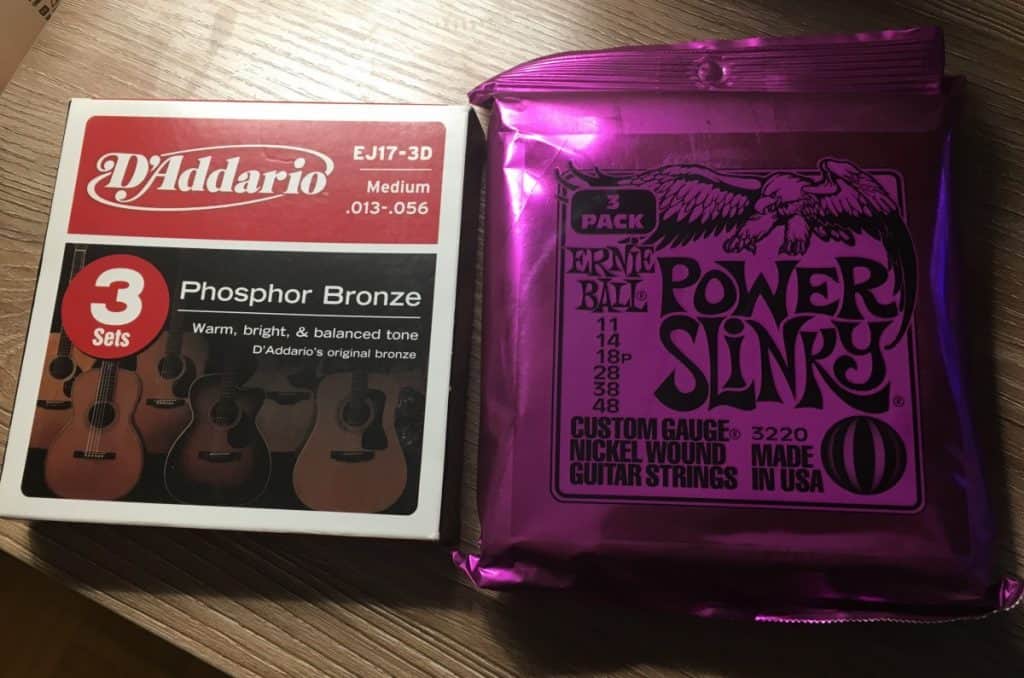
Acoustic guitars are their own speaker and need thicker more resonant strings in order to project sound from the sound-hole, compared to electric that just needs magnetically conducive strings.
This makes a lot of sense when you think about it, because electric guitars typically use amplifier/cabinet combos rather than acoustic which are solo, or at the very most, mic’d. Sometimes they’re plugged in but not THAT often.
1) Acoustic Guitar Strings Are Thicker
If you take a look at any acoustic guitar, you’ll notice right away that it has a much larger body as well as a sound-hole right in the center of it.
The idea behind this is that the strings vibrate and the sound-hole projects the sound from the wooden body out into the world for everyone to hear. Guitars are made out of wooden bodies because wood is conducive to sound.
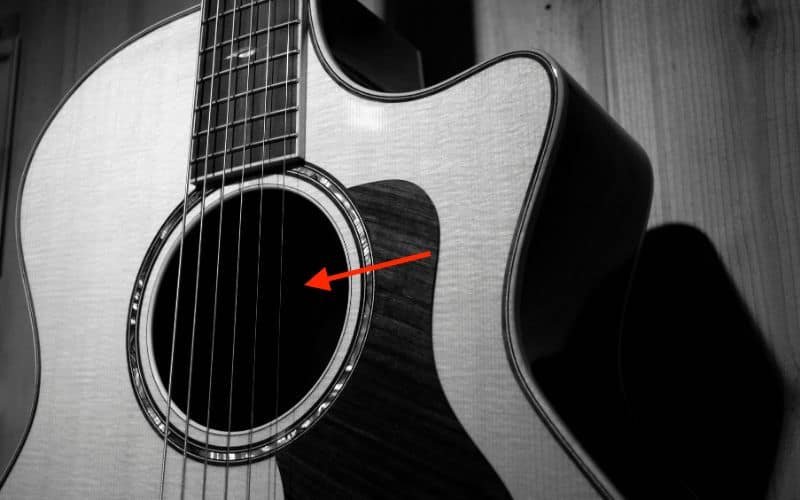
In fact, if you want to test out the conductivity of wood, take your acoustic guitar and press the headstock up against a wooden desk or a cabinet while you’re strumming chords.
You’ll notice that the sound reverberates strongly through the wooden fixture, and the larger the fixture, the more the sound is carried through it. I first discovered this when I was a kid living at my parents’ house.
Because acoustic guitars don’t use an amplifier (although, you can use an amp on an acoustic if you buy the right one), they act as their very own amplifier and speaker system. The soundhole, the body, and the guitar itself are the speaker system.
Compare this to an electric guitar that has an amplifier and cab to help project the sound far and loud.
For this reason, acoustic guitar strings need to be a bit thicker because thicker strings are supposedly much louder.
According to Making Music Mag, larger gauge strings, obviously, are thicker and have more of a vibrating mass which results in a much louder and thicker tone.
A consequence of this, however, is that you have to press down on the strings harder in order to get the same result.
In other words, acoustic guitars are usually a bit harder to play than an electric guitar because the strings are thicker and thus take more pressure to actually fret the note to the point where it’s clear and has no buzzing or string-jangling.
Moreover, some people claim heavier strings don’t go out of tune as easy, however, I’ve explored that topic before.
Anyway, so how thick are electric guitar strings compared to acoustic anyway? The three most common sizes of electric guitar strings are the following, what’s commonly and colloquially called 9s, 10s, and 11s.
It’s important to note that these are merely guidelines, and each brand has their own set which is fairly close to what’s provided below (more on guitar string setups in my guide).
9-Gauge Strings (9-42)
9-Gauge strings start with 0.009″ which is the lightest E-string. This is the diameter of the string.
0.009 (High E-String)
0.011 (B-String)
0.016 (G-String)
0.024 (D-String)
0.032 (A-String)
0.042 (Low E-String)
10-Gauge Strings (10-46)
At this point, the electric guitar strings are getting a little bit harder to play, but not by much. For many people, this is the sweet spot where string tone and playability perfectly mesh together, but of course, it depends on the player.
0.010 (High E-String)
0.013 (B-String)
0.017 (G-String)
0.026 (D-String)
0.036 (A-String)
0.046 (E-String)
11-Gauge Strings (11-52)
These are commonly the thickest strings. At 11-52, the electric guitar strings are actually getting thick enough that these could possibly be used for an acoustic guitar if they were made out of bronze, brass, or some other acoustically resonant metal. At this stage, the material they’re made out of is the one thing holding them back from being used for acoustic.
0.011 (High E-String)
0.014 (B-String)
0.018 (G-String)
0.030 (D-String)
0.042 (A-String)
0.052 (E-String)
If you take a look at acoustic guitar strings, they’re much thicker right off the bat. The lightest acoustic strings are about what the heaviest electric guitar strings are. That’s a pretty good analogy and comparison.
Acoustic Guitar String Gauges
Light – 0.012″ to 0.053″
0.012″ (High E-String)
0.016″ (B-String)
0.024″ (G-String)
0.032″ (D-String)
0.042″ (A-String)
0.053″ (Low E-String)
Medium – 0.013″ 0.056″
0.013 (High E-String)
0.017 (B-String)
0.026 (G-String)
0.035 (D-String)
0.045 (A-String)
0.056 (Low E-String)
Heavy – 0.014″ 0.059″
0.014″ (High E-String)
0.018″ (B-String)
0.027″ (G-String)
0.039 (D-String)
0.049 (A-String)
0.059 (Low E-String)
2) Acoustic Strings Are Coated With Phosphor-Bronze and Electric Are Coated With Nickel
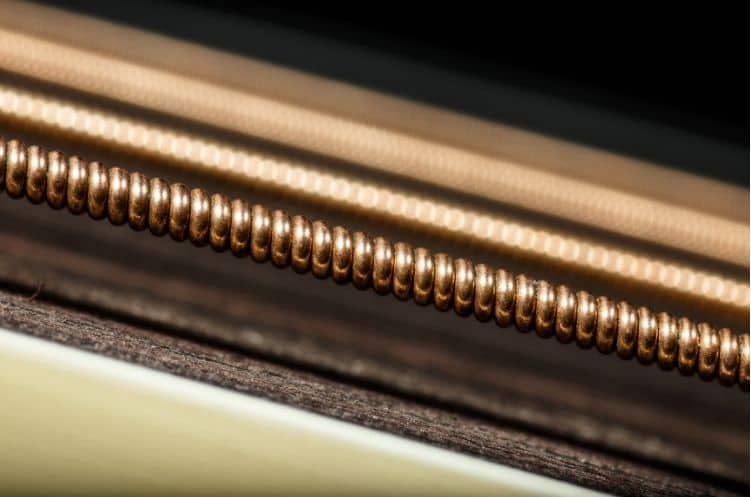
Not only are acoustic strings and electric guitar strings different in terms of size and thickness, but they’re also different in terms of their material.
Acoustic guitar strings are typically wrapped with brass or bronze, whereas electric guitar strings are wrapped with one of three materials, steel, nickel. chromium, and in many cases, they’re made out of a combination of several of them (more on how strings are made in my other article).
The reason for their different materials has to do with the purpose of the instrument again and what that purpose necessitates.
For one, acoustic guitar strings need to be more resonant and louder because the acoustic guitar is the amplifier/speaker/cab in itself. It’s not relying on an amplifier to make it sound much louder like the way that an electric guitar is.
As a result of that, it needs more acoustically resonant strings which are designed to be much louder and usually much brighter as well.
Calling back to the YouTube video above, if you check one out and see what happens when you put acoustic guitar strings on an electric guitar or vice versa, you can see these differences are actually quite substantial.
For instance, electric guitar strings are designed out of steel/nickel/chromium which is electrically and magnetically conductive. This is needed because of the pick-ups and the amplifier/cab combo which amplify the electrical signals and turn them into sound.
This means that if you use acoustic guitar strings for an electric guitar, you’ll be using a less-than-sufficient material and it won’t be as conducive electrically and magnetically.
The result of this is actually less volume and less output. In other words, the strings will actually have less power rather than more, simply because they’re not built for pickups and electrical signals.
3) Acoustic Strings are Wound Tighter Than Electric (Harder to Play)
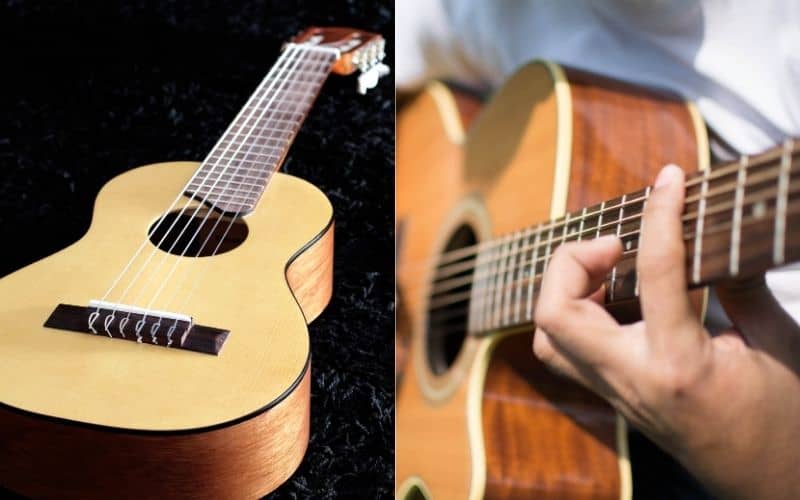
As a result of their increased thickness, acoustic guitar strings are typically wound much tighter as well which means they’re harder to play.
Because the strings are thicker, the strings are wound tighter therefore there needs to be more pressure to fret a note. Go ahead and try and play an acoustic guitar compared to an electric guitar, and you’ll notice the difference right away.
In fact, some people – including myself – will warm up on an acoustic guitar because by the time you’ve warmed upon it, you’ll move over to the electric guitar and it seems like a dream by comparison.
It’s easier to fret the notes and the strings are much closer to the fretboard as well (in other words, the action is much lower).
Are Thicker Strings Better Than Lighter Strings?
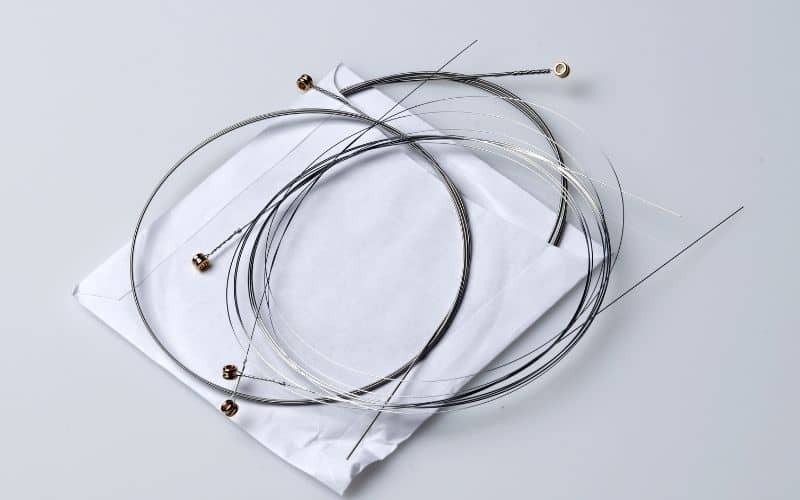
It was commonly stated in the past, including to me as well, that thicker strings were better than lighter strings and had a better tone.
For years, I used very thick strings just because I had accepted at point blank what I assumed were the opinions of more knowledgable people than me.
I was also led to believe that heavier gauge strings allowed me to have a lower action (although maybe this is true), however, a recent YouTube video by Rick Beato showed that there wasn’t much of a difference in terms of tonality.
In fact, Beato concluded that light strings were actually better. I don’t really agree with that, although, it seems like to me that light strings are definitely twangier and stronger in the upper-mid range.
In other words, I think it’s much wiser to actually try this stuff out for yourself. Don’t just take someone on the internet’s word for it.
Buy one set of each type of string thickness or brand and compare all of them to find out which ones you like. There’s a good chance you might even like the flat wound strings used for jazz.

YouTube Video Tutorial
Gear Mentioned in this Article
In terms of what one I would try first, I personally use medium gauge strings on nearly all of my guitars, although, I’ve kind of gotten sick of it over the last few years and I think that I’ll probably transition into using lighter gauges sometime in the future.
Additionally, there are some cool packs out there that are heavy on the bottom strings and light on the top, like Ernie Ball’s Skinny-Top Heavy-Bottom. (All of the links down below take you to Amazon).

 Written By :
Written By :
